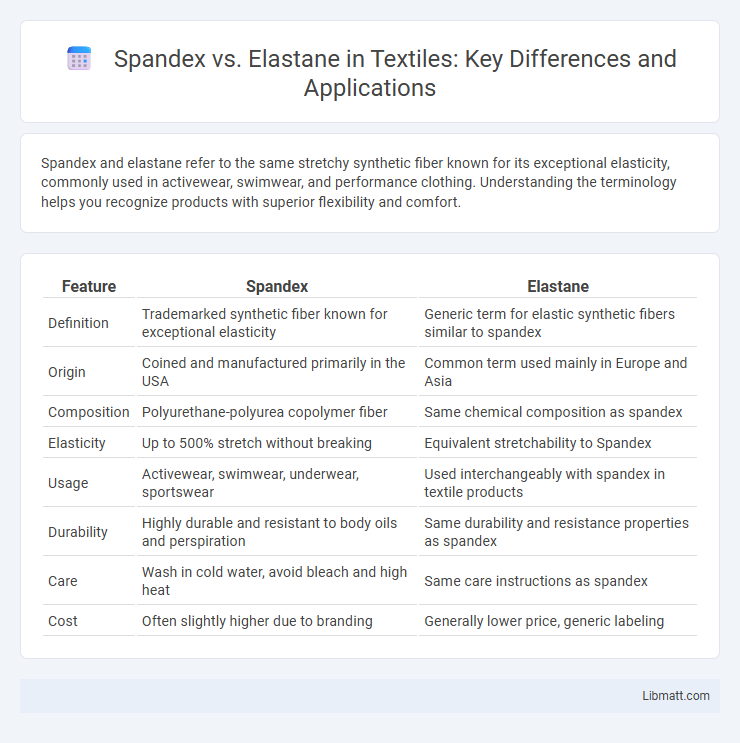Spandex and elastane refer to the same stretchy synthetic fiber known for its exceptional elasticity, commonly used in activewear, swimwear, and performance clothing. Understanding the terminology helps you recognize products with superior flexibility and comfort.
Table of Comparison
| Feature | Spandex | Elastane |
|---|---|---|
| Definition | Trademarked synthetic fiber known for exceptional elasticity | Generic term for elastic synthetic fibers similar to spandex |
| Origin | Coined and manufactured primarily in the USA | Common term used mainly in Europe and Asia |
| Composition | Polyurethane-polyurea copolymer fiber | Same chemical composition as spandex |
| Elasticity | Up to 500% stretch without breaking | Equivalent stretchability to Spandex |
| Usage | Activewear, swimwear, underwear, sportswear | Used interchangeably with spandex in textile products |
| Durability | Highly durable and resistant to body oils and perspiration | Same durability and resistance properties as spandex |
| Care | Wash in cold water, avoid bleach and high heat | Same care instructions as spandex |
| Cost | Often slightly higher due to branding | Generally lower price, generic labeling |
Introduction to Spandex and Elastane
Spandex and elastane refer to the same synthetic fiber known for exceptional elasticity, widely used in sportswear, activewear, and undergarments. Manufactured from polyurethane polymers, this fiber provides stretch and recovery, enhancing garment comfort and fit. Both terms are interchangeable, with "spandex" commonly used in the US and "elastane" preferred in Europe and other regions.
What is Spandex?
Spandex is a synthetic fiber known for its exceptional elasticity, commonly used in activewear, swimwear, and stretchy garments. It is composed of a polyurethane-polyurea copolymer that allows fabrics to stretch up to five times their original length without losing shape. Your clothing benefits from Spandex's durability and flexibility, providing comfort and enhanced movement in everyday wear.
What is Elastane?
Elastane, also known as spandex or Lycra, is a synthetic fiber renowned for its exceptional elasticity and stretchability, typically made from polyurethane. It is widely used in activewear, swimwear, and undergarments due to its ability to retain shape and provide comfort. Elastane fibers can stretch up to five times their original length, making them essential for garments requiring flexibility and durability.
Spandex vs Elastane: Key Differences
Spandex and elastane are different terms for the same synthetic fiber known for exceptional stretch and recovery, widely used in activewear and apparel. The key difference lies in regional terminology: "spandex" is commonly used in the United States, while "elastane" is the preferred term in Europe and internationally. Understanding this can help you make informed choices when purchasing or designing fabrics that require flexibility and durability.
Similarities Between Spandex and Elastane
Spandex and elastane are chemically identical synthetic fibers known for their exceptional elasticity and stretchability, commonly used in activewear, swimwear, and hosiery. Both fibers provide excellent shape retention and comfort, enabling garments to move with your body while maintaining a snug fit. You can expect similar performance and durability from fabrics labeled as either spandex or elastane, as the terms are interchangeable depending on regional preferences.
Common Applications in Fashion and Sportswear
Spandex and elastane are widely used in fashion and sportswear for their exceptional stretch and recovery properties, enhancing comfort and fit. These fibers are common in activewear, swimwear, leggings, and performance gear, providing flexibility and durability during physical activities. Your clothing benefits from their ability to maintain shape and support movement, making them essential in both everyday apparel and high-performance sportswear.
Durability and Comfort Comparison
Spandex and elastane are often used interchangeably, but their durability and comfort can vary slightly depending on manufacturing quality and fabric blend. Spandex offers excellent stretch and recovery, ensuring long-lasting elasticity that retains shape and provides superior comfort during extended wear. Your choice between these fibers should consider the specific garment's intended use, with elastane sometimes providing a softer feel while maintaining comparable durability to spandex.
Care and Maintenance Tips
Spandex and elastane, both known for their exceptional elasticity in activewear and swimwear, require gentle care to maintain their stretch and durability. Wash garments made from these fibers in cold water using mild detergent and avoid bleach or fabric softeners to prevent fiber damage and loss of elasticity. Air drying is essential to preserve the fabric's integrity, as high heat from dryers can cause shrinkage and weaken the elastic properties.
Environmental Impact and Sustainability
Spandex and elastane, often used interchangeably, have similar environmental impacts due to their synthetic polyurethane base, which relies heavily on fossil fuels and energy-intensive production processes. Both fibers are non-biodegradable, contributing to long-term environmental pollution and microplastic contamination in water bodies during washing. Efforts to improve sustainability focus on recycled variants and blends with natural fibers to reduce the carbon footprint and encourage circular fashion practices.
Choosing the Right Fabric for Your Needs
Spandex and elastane are interchangeable terms for a highly stretchable synthetic fiber used in activewear, swimwear, and compression garments. Choosing the right fabric involves considering the blend ratio, as higher spandex content offers greater elasticity and shape retention, while elastane blends often enhance breathability and comfort. Evaluate your specific needs for flexibility, durability, and moisture-wicking properties to select the best fabric for performance and style.
Spandex vs Elastane Infographic

 libmatt.com
libmatt.com